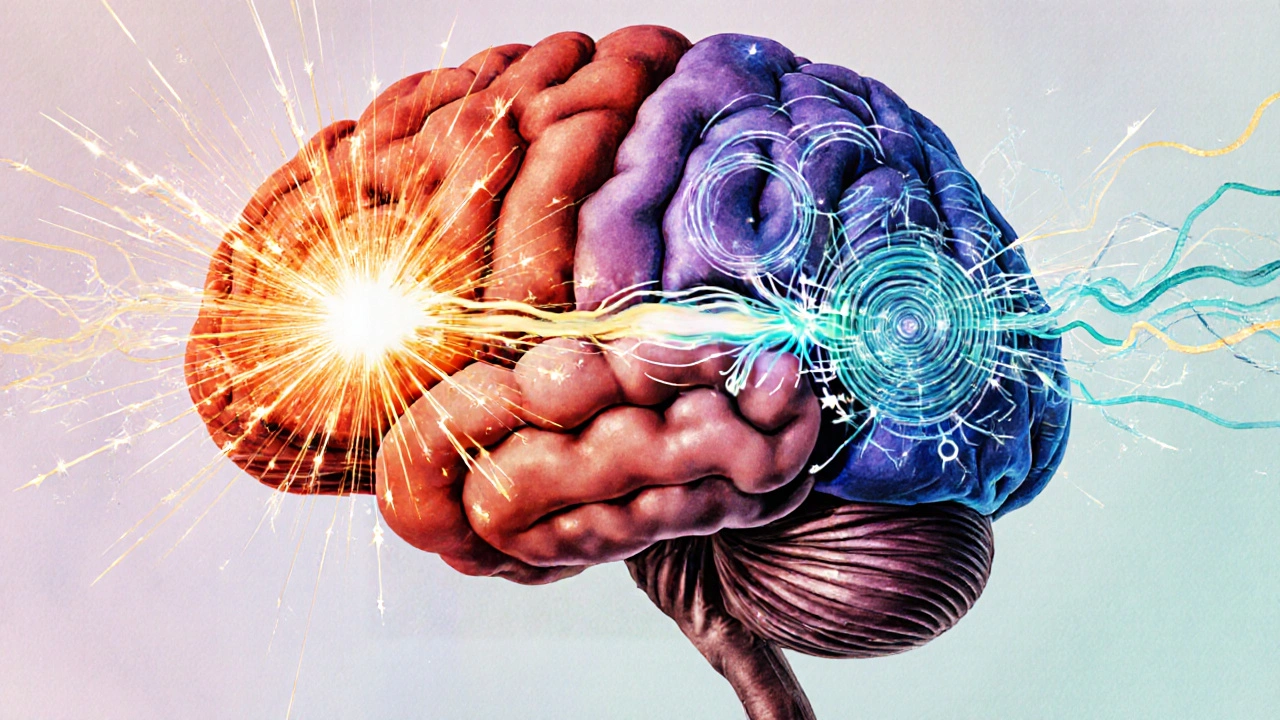Panic & OCD Symptom Checker
This tool helps identify potential symptoms of panic disorder and obsessive-compulsive disorder (OCD). Please select all that apply to your experiences.
Panic Disorder Symptoms
OCD Symptoms
When panic attacks and compulsive rituals start showing up together, it can feel like a double‑whammy that makes daily life feel impossible. Understanding why panic disorder and obsessive‑compulsive disorder (OCD) often walk side‑by‑side is the first step toward breaking the cycle.
What Is Panic Disorder?
Panic Disorder is a type of anxiety disorder characterized by recurrent, unexpected panic attacks and persistent fear of having more attacks. It typically begins in late adolescence or early adulthood, affecting about 2‑3% of the population worldwide. Common triggers include stress, caffeine, or even a quiet moment when the body’s alarm system misfires.
Key features include sudden spikes of heart racing, shortness of breath, chest pain, and a feeling that something terrible is about to happen. The attacks peak within minutes and can leave a lingering dread that interferes with work, relationships, and sleep.
What Is Obsessive‑Compulsive Disorder?
Obsessive‑Compulsive Disorder is a chronic mental health condition marked by intrusive, unwanted thoughts (obsessions) and repetitive behaviors (compulsions) performed to reduce anxiety. Roughly 1‑2% of adults experience OCD, with symptoms often emerging in the teens.
Obsessions might involve fears of contamination, harming others, or a need for symmetry. Compulsions include excessive hand‑washing, checking locks, or arranging items in a precise order. The cycle of obsession → anxiety → compulsion reinforces itself, making it hard to break without targeted help.
How Often Do They Co‑occur?
Comorbidity-the occurrence of two disorders in the same person-is common. Studies from the World Health Organization report that up to 30% of people with panic disorder also meet criteria for OCD, while 20% of those with OCD experience panic attacks. This overlap isn’t random; both conditions share genetic risk factors, similar brain‑circuit dysfunctions, and a heightened sensitivity to perceived threats.
Understanding comorbidity matters because treatment plans that ignore one disorder often fall short. A person who receives exposure therapy for panic but not for obsessive thoughts may still feel trapped by the compulsions that fuel anxiety.
Shared Symptoms & Overlapping Features
Although panic attacks and compulsions look different, they share several core elements:
- Intense anxiety that can surge without an obvious external trigger.
- Avoidance behaviors: a panic‑prone individual may avoid crowded places, while an OCD sufferer might avoid touching “contaminated” objects.
- Physical sensations: rapid heartbeat, shortness of breath, and muscle tension appear in both.
Because these symptoms can mask each other, clinicians often need detailed assessments to untangle whether a person’s avoidance stems from fear of panic, fear of contamination, or both.

Brain Chemistry Links
Neuroimaging research points to two brain regions that play starring roles in both disorders:
- Amygdala: the alarm center that over‑reacts to perceived danger, leading to the sudden surge of panic.
- Orbitofrontal Cortex: involved in decision‑making and error‑monitoring; hyperactivity here fuels obsessive thoughts and compulsive checking.
Both disorders also involve serotonin dysregulation. Low serotonin levels can amplify anxiety, which is why Selective Serotonin Reuptake Inhibitors (SSRIs) are frequently prescribed for each condition. The overlap in neurobiology explains why a medication that eases panic often reduces obsessive urges, and vice‑versa.
Treatment Strategies That Target Both
Because panic disorder and OCD share underlying mechanisms, integrated treatment approaches work best. Below is a quick rundown of the most evidence‑based options.
| Treatment | Primary Target | Effect on Panic | Effect on OCD |
|---|---|---|---|
| Cognitive Behavioral Therapy (CBT) | Thought‑behavior patterns | Reduces catastrophic thinking | Teaches exposure to obsessions |
| Exposure and Response Prevention (ERP) | Compulsive rituals | Can be adapted for interoceptive exposure | Gold standard for OCD |
| Selective Serotonin Reuptake Inhibitors (SSRIs) | Serotonin imbalance | Often decreases panic frequency | Reduces obsessions and compulsions |
| Mindfulness‑Based Stress Reduction (MBSR) | Present‑moment awareness | Improves tolerance of bodily sensations | Helps break the urge‑compulsion loop |
Cognitive Behavioral Therapy (CBT) remains the cornerstone. For panic, therapists use interoceptive exposure-deliberately inducing physical sensations (like hyperventilating) to prove they’re harmless. For OCD, exposure focuses on confronting feared thoughts while resisting the compulsion (the classic ERP).
Medication can smooth the way for therapy. SSRIs such as sertraline, fluoxetine, or escitalopram are FDA‑approved for both disorders. Starting at a low dose and titrating up minimizes side‑effects while providing enough serotonin boost to calm the amygdala and orbitofrontal pathways.
When therapy and medication alone aren’t enough, Mindfulness‑Based Stress Reduction (MBSR) offers a gentle adjunct. By learning to observe bodily sensations without judgment, patients can break the automatic panic‑OCD feedback loop.
Practical Tips for Managing Co‑occurring Conditions
- Track triggers in a single journal. Note when panic spikes, what thoughts preceded it, and any compulsive behavior that followed. Patterns often reveal that a single stressor fuels both.
- Practice paced breathing. Slow, diaphragmatic breaths lower heart rate, reducing the physiological cue that the brain interprets as danger.
- Schedule “worry time.” Set a 15‑minute window each day to write down intrusive thoughts. Outside that window, gently redirect attention back to the present.
- Use exposure hierarchies. Start with mildly anxiety‑provoking situations (e.g., looking at a news headline about disease) and gradually work up to the most feared scenarios.
- Lean on support networks. Friends, family, or OCD‑focused support groups can provide accountability and reduce isolation.
Remember, the goal isn’t to eliminate anxiety completely-just to prevent it from hijacking daily life.
When to Seek Professional Help
If panic attacks become so frequent that you avoid work, or if compulsions consume more than an hour each day, it’s time to talk to a mental‑health professional. A qualified therapist will assess for comorbid depression, substance use, or other anxiety disorders, ensuring a comprehensive treatment plan.
Early intervention matters. The longer the cycle persists, the more entrenched the brain pathways become, making recovery slower. Don’t wait for the next panic attack to be the “tipping point.” Reach out now and ask about therapists who specialize in both panic disorder and OCD.
Frequently Asked Questions
Can panic disorder cause OCD, or is it the other way around?
Neither disorder directly causes the other. They share risk factors-genetics, brain chemistry, and stress-that make it easier for both to develop. One can exacerbate the other, but causation is a two‑way street.
Is medication enough to treat both conditions?
Medication often reduces the intensity of symptoms, but without therapy many people continue to rely on avoidance or compulsions. Combining SSRIs with CBT or ERP yields the best long‑term outcomes.
Do lifestyle changes help?
Yes. Regular exercise, consistent sleep, reduced caffeine, and mindfulness practices lower overall anxiety levels, making both panic attacks and obsessive thoughts less frequent.
Can I self‑diagnose?
Self‑assessment tools can give you a hint, but only a qualified clinician can confirm a diagnosis. Misdiagnosis can lead to ineffective treatment, so professional evaluation is essential.
What’s the success rate of treatment for people with both disorders?
When both panic disorder and OCD are addressed simultaneously-using medication plus tailored CBT/ERP-about 70% of patients report a significant reduction in symptoms within six months.
